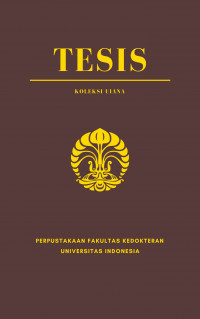Tesis
Neuroplastisitas dan Pemulihan Motorik Anggota Gerak Atas Pada Rehabilitasi Berbasis Motor Imagery Pasien Stroke Iskemik Kronik Dengan Hemiparesis: Studi Serial Kasus = Neuroplasticity and Motor Recovery of Upper Limb in Motor Imagery- Based Rehabilitation of Chronic Ischemic Stroke Patients With Hemiparesis: A Case Series Study.
PENDAHULUAN: Teknik motor imagery diketahui berpengaruh terhadap fungsi motorik anggota gerak atas pasien stroke iskemik kronik. Meskipun demikian, belum diketahui pengaruh teknik motor imagery terhadap neuroplastisitas secara molekular pada pasien stroke iskemik kronik. Penelitian ini bertujuan mengetahui pengaruh teknik motor imagery terhadap fungsi anggota gerak atas dan neuroplastisitas pasien stroke iskemik kronik. METODE: Kami melaporkan 3 kasus stroke iskemik kronik. Kasus pertama wanita usia 40 tahun dengan stroke pertama awitan 5 tahun dan komorbid systemic lupus erythematosus (SLE). Kasus kedua wanita usia 53 tahun dengan stroke pertama awitan 3 tahun, komorbid hipertensi dan diabetes mellitus tipe 2. Kasus ketiga pria usia 51 tahun dengan stroke berulang ketiga awitan 1 tahun, komorbid hipertensi dan hiperlipidemia. Kami melakukan intervensi teknik motor imagery 1 sesi per minggu selama 12 minggu, dengan durasi 20 menit per sesi, menggunakan panduan elektroensefalografi (EEG) elektroda tunggal portabel. Luaran fungsional dinilai dengan Chedoke Arm and Hand Activity Inventory-13 (CAHAI-13) sebelum dan sesudah intervensi. Parameter neuroplastisitas diukur dari kadar Brain Derived Neurotrophic Factor (BDNF) serum yang dinilai pada pra-intervensi, minggu ke-6, dan pasca-intervensi minggu ke-12 HASIL: Pemulihan fungsi anggota gerak atas yang bermakna secara klinis didapatkan pada kasus kedua dengan peningkatan skor CAHAI-13 sebesar 21 poin disertai peningkatan kadar BDNF serum pada minggu ke-6 yang relatif menetap pada pengukuran minggu ke-12. Pada kasus ketiga didapatkan peningkatan skor CAHAI-13 yang tidak bermakna secara klinis, sementara pada kasus pertama tidak didapatkan perubahan. Kadar BDNF pada kasus pertama dan ketiga memiliki kecenderungan yang sama, yaitu meningkat pada minggu ke-6, dan turun kembali pada minggu ke-12 dengan kadar yang masih lebih tinggi dibandingkan kadar pra-intervensi. KESIMPULAN: Teknik motor imagery 1 sesi per minggu selama 12 minggu, durasi 20 menit per sesi, terbukti berpengaruh terhadap neuroplastisitas pasien stroke iskemik kronik, dan terhadap pemulihan motorik anggota gerak atas pasien stroke iskemik kronik serangan pertama awitan 3 tahun.
Kata kunci: Brain-Derived Neurotrophic Factor, stroke iskemik, motor imagery, neuroplastisitas, anggota gerak atas
INTRODUCTION: Motor imagery is known to affect motor function of upper limbs in chronic ischemic stroke patients. However, the effect of motor imagery on molecular neuroplasticity in chronic ischemic stroke patients is not yet established. This study aims to determine the efect of motor imagery on upper limb function and neuroplasticity of chronic ischemic stroke patients. METHODS: We reported 3 cases of chronic ischemic stroke. The first case was a 40year-old woman with stroke onset 5 years and comorbid systemic lupus erythematosus (SLE). The second case was a 53-year-old woman with a first stroke of 3 years onset, comorbid hypertension and diabetes mellitus type 2. The third case was a 51-year-old with third recurrent stroke of 1 year onset, comorbid hypertension and hyperlipidemia. We performed motor imagery 1 session per week for 12 weeks, with a duration of 20 minutes per session, using single electrode portable electroencephalograph (EEG) guidance. Functional outcomes were assessed using the Chedoke Arm and Hand Activity Inventory-13 (CAHAI-13) before and after intervention. Neuroplasticity parameters were measured from serum Brain Derived Neurotrophic Factor (BDNF) levels which were assessed at pre-intervention, week 6, and week 12 post-intervention. RESULTS: Clinically significant recovery of upper limb function was found in the second case with an increase in the CAHAI-13 score of 21 points, accompanied by an increase in serum BDNF levels at week 6 which was relatively stable at week 12. In the third case, there was an increase in the CAHAI-13 score which was not clinically significant, while in the first case there was no change. Serum BDNF levels in the first and third cases had the same tendency, which increased at week 6 and decreased at week 12, with the levels still higher than pre-intervention levels. CONCLUSION: Motor imagery 1 session per week for 12 weeks, with the duration of 20 minutes per session, has been shown to have an effect on neuroplasticity of chronic ischemic stroke patients, and on motor recovery of limbs in patient with first chronic ischemic stroke of 3 years onset.
Key words: Brain-Derived Neurotrophic Factor, ischemic stroke, motor imagery, neuroplasticity, upper limb
- Judul Seri
-
-
- Tahun Terbit
-
2021
- Pengarang
-
Edwin Goutama - Nama Orang
Herqutanto - Nama Orang
Sylvia Detri Elvira - Nama Orang
Widjajalaksmi K - Nama Orang - No. Panggil
-
T21506fk
- Penerbit
- Jakarta : Program Studi Kedokteran Fisik dan Rehabilitasi., 2021
- Deskripsi Fisik
-
xvii, 126 hlm. ; 21 x 30 cm
- Bahasa
-
Indonesia
- ISBN/ISSN
-
-
- Klasifikasi
-
NONE
- Edisi
-
-
- Subjek
- Info Detail Spesifik
-
Tanpa Hardcopy
| T21506fk | T21506fk | Perpustakaan FKUI | Tersedia |


Masuk ke area anggota untuk memberikan review tentang koleksi